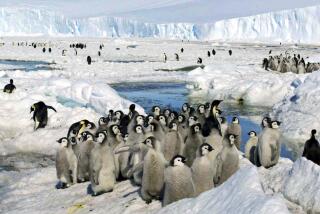As the Coolest Hawkers of the ‘90s, Penguins Are in Their Element
- Share via
TRENTON, N.J. — For a bunch of flightless birds confined to the Southern Hemisphere, penguins are really getting around.
They’re driving BMWs, riding trains and exploring the jungle to get a Bud Ice, trekking across ice floes to a Canada Dry machine, even strutting inside a Smirnoff vodka bottle wearing tuxedos complete with cummerbund.
The often comical birds also hawk N’Ice cough drops, Aetna retirement plans and the Mercury Mountaineer. They’ve helped market a photocopier and lent their name or image to Penguin Cookies, Penguin Books, Munsingwear golf shirts, and numerous lines of water ice, frozen yogurt and ice cubes.
“There seems to be a flurry of things connected to penguins right now,” says Arlene Gerwin, Smirnoff’s consumer marketing manager. “There’s just something charismatic about penguins.”
Smirnoff is using emperor penguins--at 4 feet, the tallest of the 18 penguin species--in its “Pure Thrill” campaign contrasting extraordinary things inside its bottle with the mundane outside. The penguin in the bottle sports tailored formal wear, while the ones outside are in their birthday suits.
Marketing executives say penguins test very strongly among focus groups.
“They get attention,” says Charlotte Campbell, president of the New York advertising firm Diagnostic Research International. “Everyone seems to gravitate to them.”
Campbell’s firm tested a print ad that Xerox used to promote its copier-printers’ ability to integrate color with black and white, illustrated by a colorful parrot amid four Adelie penguins, the classic black-and-white penguins known best.
Campbell--now testing another penguin ad for a client she can’t name--notes that most ads using penguins are for products associated with cold or rugged conditions.
That’s true for N’Ice cough drops and the Mountaineer ad, which shows the four-wheel-drive vehicle driving past a flock of penguins. Ditto for the Canada Dry ads and Anheuser-Busch’s “Beware the Penguins” campaign for its Bud Ice brand.
The Bud Ice penguin, who stalks people until they hand over the beer, is actually an actor in a suit whose image is reduced and superimposed on each scene.
Canada Dry uses real and computer-generated penguins to create TV and billboard ads linking its soft drinks with “the freshness and outdoor quality” of the birds, said Catherine Van Evans, spokeswoman for brand owner Dr. Pepper-Seven Up.
Some penguin species are getting so much exposure, one would think they had an agent.
Some do, sort of.
“They love to work,” says penguin trainer Linda Arnold, whose nine “kids” appeared in “Batman Returns” and “Hook,” several television programs and commercials for Canada’s Arctic detergent, Aetna and BMW.
They are African black-footed penguins, which live in relatively warm weather and can withstand studio lights, unlike emperors and other Antarctic species.
“The last two years, we’ve done quite a bit,” says Arnold, a trainer for Birds & Animals Unlimited of Lake Forest, which provides animals for the advertising and entertainment industries.
Her penguins, also called jackass penguins for their braying sound, appear in a print ad for Aetna Retirement Services. The ad had a picture of a beaming middle-aged man approaching the flock, and text promoting financial planning “for your next grand adventure.”
The birds also drive a BMW 328i, once considered lousy in the snow, in TV ads touting the car’s new traction-control system. A computer-generated, generic-looking penguin keeps slipping down an icy slope before the real African penguin drives off. (Arnold won’t let her penguins risk a work injury.)
“The advertising has had a definite impact” on sales, says Richard Brooks, marketing manager at BMW of North America in Woodcliff Lake. Response to the ad has been “tremendously positive, so much so that we have developed penguin ties and penguin stuffed animals that are sold through our dealerships.”
Anheuser-Busch also markets items related to its ads, from T-shirts and caps to key chains and cooler cups. It also exhibits a huge, inflated, Bud Ice-clutching penguin outside arenas at sporting events.
One of the first products to use penguins regularly was N’Ice cough drops, which started in 1989.
“I do believe we were penguin pioneers,” says Linda Cornelius, a senior partner at manufacturer SmithKline Beecham’s advertising firm. “They were a really logical choice for us,” given their connection to ice.
“There was sort of a cute aspect to the theme as well . . . with these lively, anthropomorphic penguins,” she says. The talking, cartoonish penguins first used have been replaced by a documentary-style footage of emperor penguins enduring the Antarctic winter while a narrator declares N’Ice is preferred “where it’s always cold season.”
Even when they’re not selling a particular product, penguins are popular. The inside cover of a recent Eddie Bauer catalog shows a flock of king penguins next to copy beginning, “Fortunately, dress codes aren’t as rigid as they used to be.”
Penguins, which have their own World Wide Web site, are just as marketable themselves.
Besides plush versions of Adelies, chinstraps, rockhoppers and other species, there’s the ever-popular Opus character from the “Bloom County” and “Outland” comic strips. Milton Bradley introduced the Penguin Shuffle game for Christmas, and the Playful Penguin and other toys have been around for years.
Baltimore and New York both have Next Stop South Pole shops selling everything penguin: adorable slippers, plush animals, clothing, jewelry and housewares, even shower curtains.
About the only thing you can’t buy there is a real penguin.
More to Read
Sign up for Essential California
The most important California stories and recommendations in your inbox every morning.
You may occasionally receive promotional content from the Los Angeles Times.













